ACCG224: Financial Accounting Policies and Estimates Report, S2 2019
VerifiedAdded on 2022/10/17
|9
|1716
|40
Report
AI Summary
This report provides an in-depth analysis of accounting policies and estimates, specifically focusing on the requirements of AASB 108, changes in accounting policies, and their practical application within financial accounting. The report discusses the selection criteria for accounting policies and estimates, emphasizing the importance of professional judgment in financial reporting. It examines the accounting policy of Wesfarmers Limited concerning property, plant, and equipment, including depreciation methods, useful lives, and the treatment of impairments. The report also highlights potential improvements in accounting practices, such as considering legal limits on asset use and consulting external sources for determining asset values. Furthermore, it explores the impact of changes in accounting estimates on financial statements and the importance of providing relevant and reliable information to decision-makers. The report concludes by emphasizing the significance of adhering to relevant accounting standards and the need for fair disclosure in financial statements.
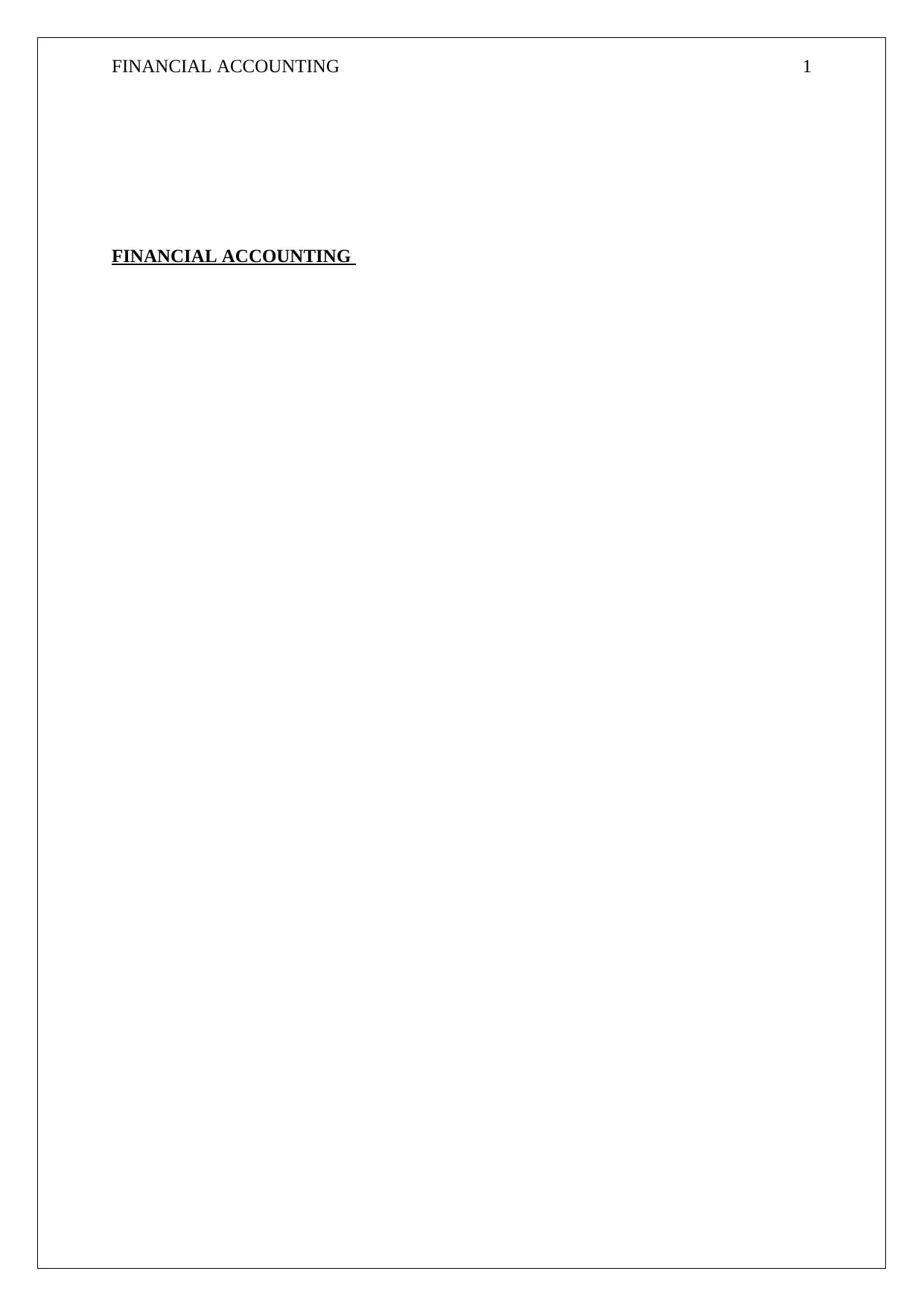
FINANCIAL ACCOUNTING 1
FINANCIAL ACCOUNTING
FINANCIAL ACCOUNTING
Paraphrase This Document
Need a fresh take? Get an instant paraphrase of this document with our AI Paraphraser
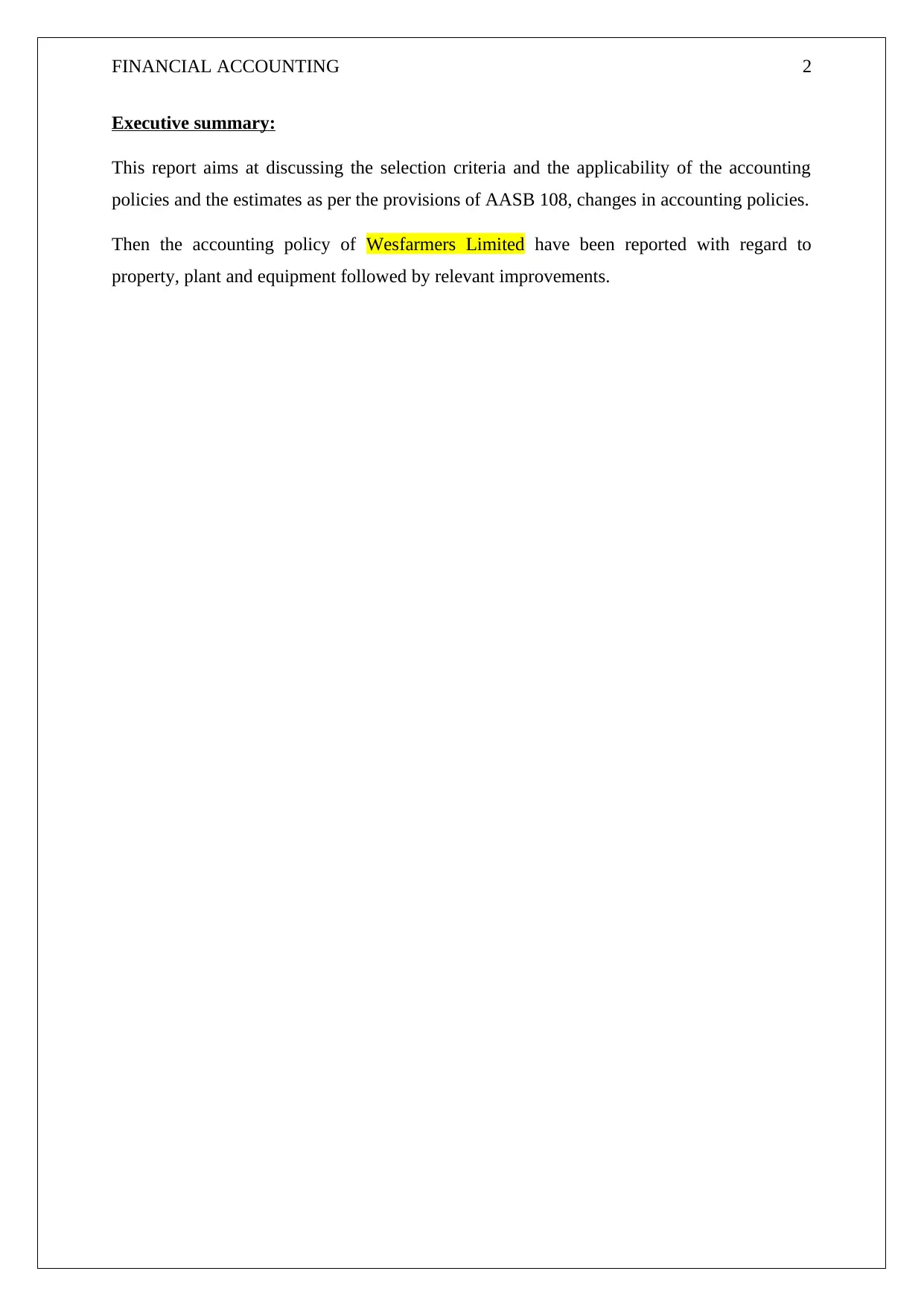
FINANCIAL ACCOUNTING 2
Executive summary:
This report aims at discussing the selection criteria and the applicability of the accounting
policies and the estimates as per the provisions of AASB 108, changes in accounting policies.
Then the accounting policy of Wesfarmers Limited have been reported with regard to
property, plant and equipment followed by relevant improvements.
Executive summary:
This report aims at discussing the selection criteria and the applicability of the accounting
policies and the estimates as per the provisions of AASB 108, changes in accounting policies.
Then the accounting policy of Wesfarmers Limited have been reported with regard to
property, plant and equipment followed by relevant improvements.
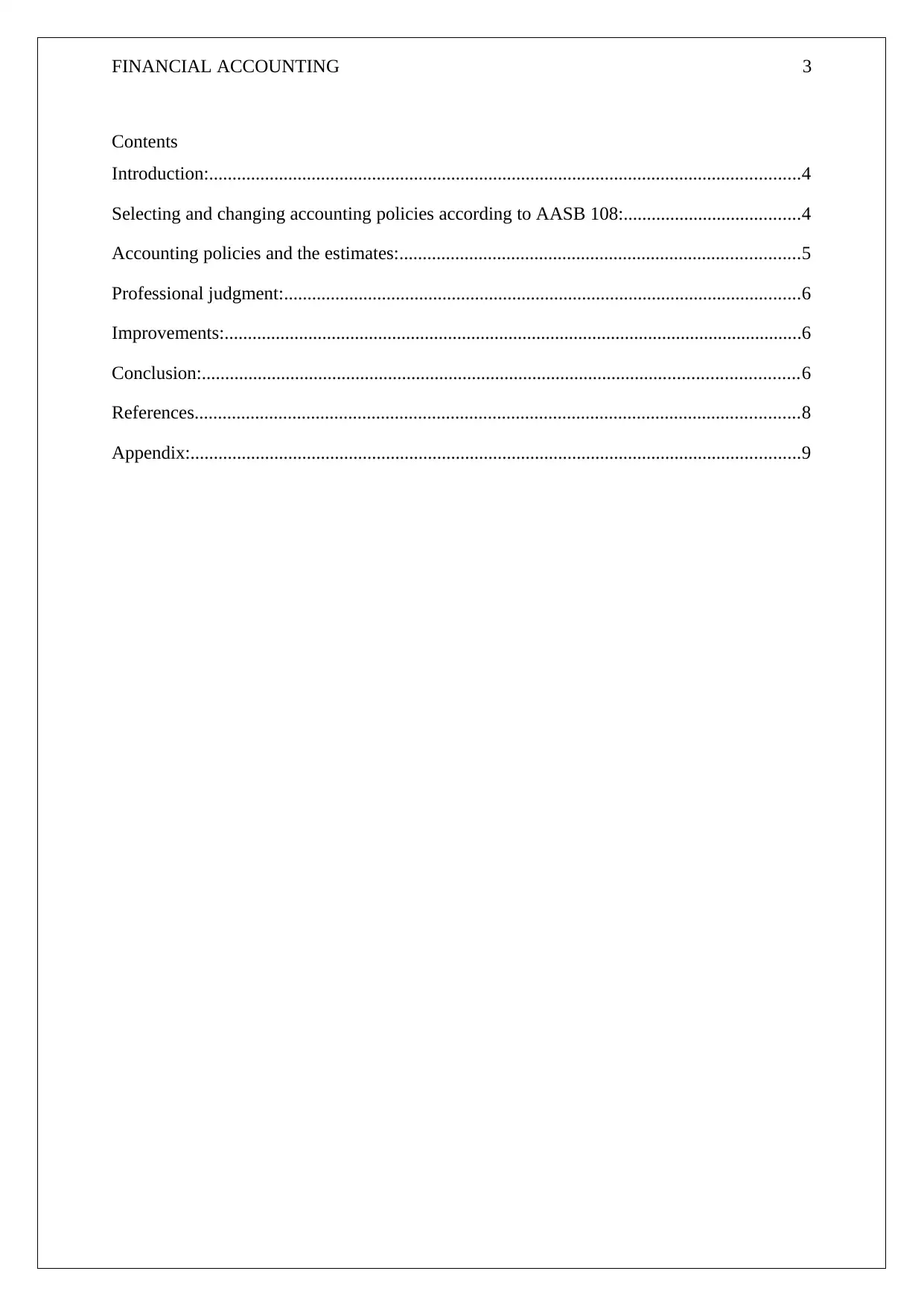
FINANCIAL ACCOUNTING 3
Contents
Introduction:...............................................................................................................................4
Selecting and changing accounting policies according to AASB 108:......................................4
Accounting policies and the estimates:......................................................................................5
Professional judgment:...............................................................................................................6
Improvements:............................................................................................................................6
Conclusion:................................................................................................................................6
References..................................................................................................................................8
Appendix:...................................................................................................................................9
Contents
Introduction:...............................................................................................................................4
Selecting and changing accounting policies according to AASB 108:......................................4
Accounting policies and the estimates:......................................................................................5
Professional judgment:...............................................................................................................6
Improvements:............................................................................................................................6
Conclusion:................................................................................................................................6
References..................................................................................................................................8
Appendix:...................................................................................................................................9
⊘ This is a preview!⊘
Do you want full access?
Subscribe today to unlock all pages.

Trusted by 1+ million students worldwide
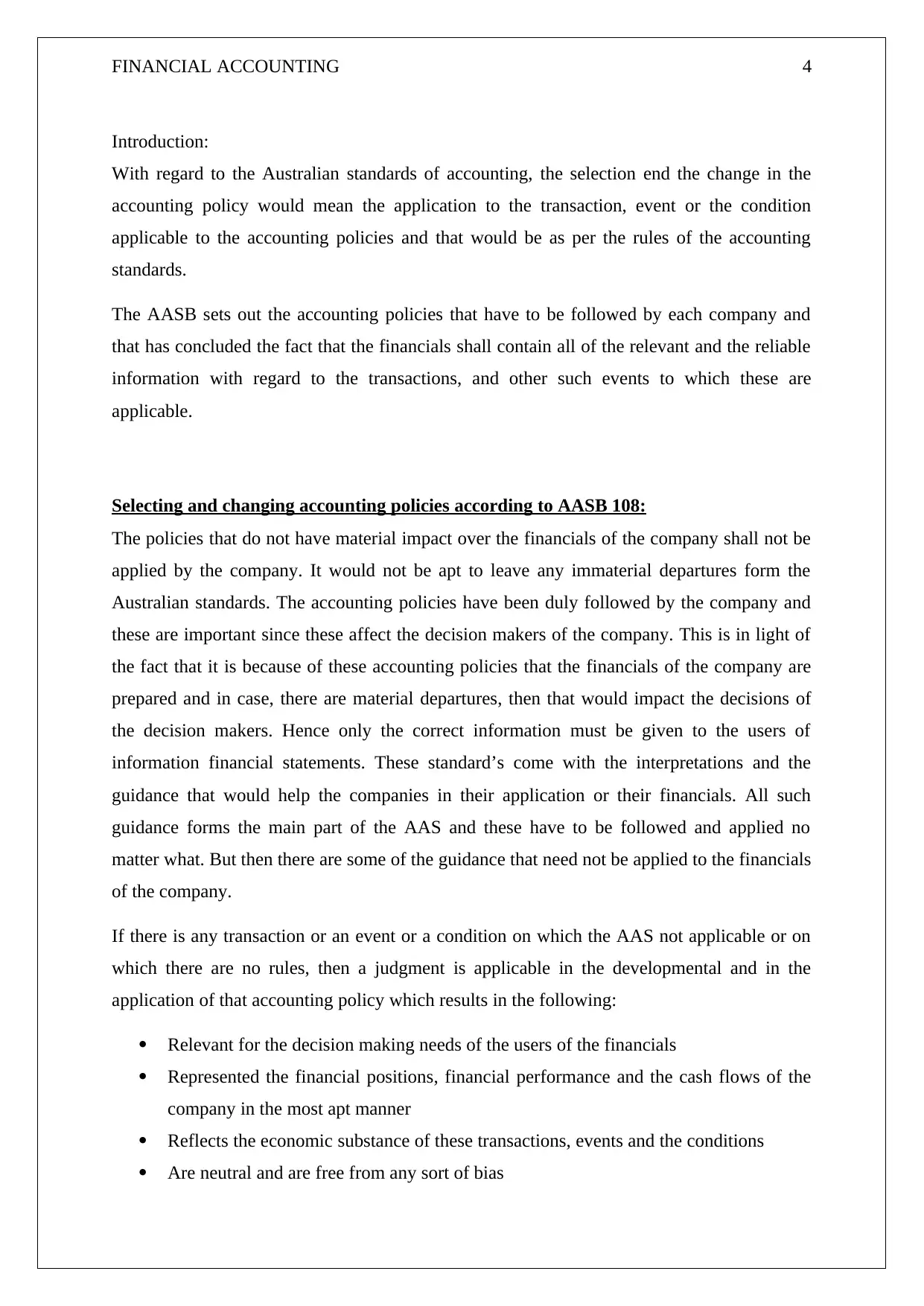
FINANCIAL ACCOUNTING 4
Introduction:
With regard to the Australian standards of accounting, the selection end the change in the
accounting policy would mean the application to the transaction, event or the condition
applicable to the accounting policies and that would be as per the rules of the accounting
standards.
The AASB sets out the accounting policies that have to be followed by each company and
that has concluded the fact that the financials shall contain all of the relevant and the reliable
information with regard to the transactions, and other such events to which these are
applicable.
Selecting and changing accounting policies according to AASB 108:
The policies that do not have material impact over the financials of the company shall not be
applied by the company. It would not be apt to leave any immaterial departures form the
Australian standards. The accounting policies have been duly followed by the company and
these are important since these affect the decision makers of the company. This is in light of
the fact that it is because of these accounting policies that the financials of the company are
prepared and in case, there are material departures, then that would impact the decisions of
the decision makers. Hence only the correct information must be given to the users of
information financial statements. These standard’s come with the interpretations and the
guidance that would help the companies in their application or their financials. All such
guidance forms the main part of the AAS and these have to be followed and applied no
matter what. But then there are some of the guidance that need not be applied to the financials
of the company.
If there is any transaction or an event or a condition on which the AAS not applicable or on
which there are no rules, then a judgment is applicable in the developmental and in the
application of that accounting policy which results in the following:
Relevant for the decision making needs of the users of the financials
Represented the financial positions, financial performance and the cash flows of the
company in the most apt manner
Reflects the economic substance of these transactions, events and the conditions
Are neutral and are free from any sort of bias
Introduction:
With regard to the Australian standards of accounting, the selection end the change in the
accounting policy would mean the application to the transaction, event or the condition
applicable to the accounting policies and that would be as per the rules of the accounting
standards.
The AASB sets out the accounting policies that have to be followed by each company and
that has concluded the fact that the financials shall contain all of the relevant and the reliable
information with regard to the transactions, and other such events to which these are
applicable.
Selecting and changing accounting policies according to AASB 108:
The policies that do not have material impact over the financials of the company shall not be
applied by the company. It would not be apt to leave any immaterial departures form the
Australian standards. The accounting policies have been duly followed by the company and
these are important since these affect the decision makers of the company. This is in light of
the fact that it is because of these accounting policies that the financials of the company are
prepared and in case, there are material departures, then that would impact the decisions of
the decision makers. Hence only the correct information must be given to the users of
information financial statements. These standard’s come with the interpretations and the
guidance that would help the companies in their application or their financials. All such
guidance forms the main part of the AAS and these have to be followed and applied no
matter what. But then there are some of the guidance that need not be applied to the financials
of the company.
If there is any transaction or an event or a condition on which the AAS not applicable or on
which there are no rules, then a judgment is applicable in the developmental and in the
application of that accounting policy which results in the following:
Relevant for the decision making needs of the users of the financials
Represented the financial positions, financial performance and the cash flows of the
company in the most apt manner
Reflects the economic substance of these transactions, events and the conditions
Are neutral and are free from any sort of bias
Paraphrase This Document
Need a fresh take? Get an instant paraphrase of this document with our AI Paraphraser
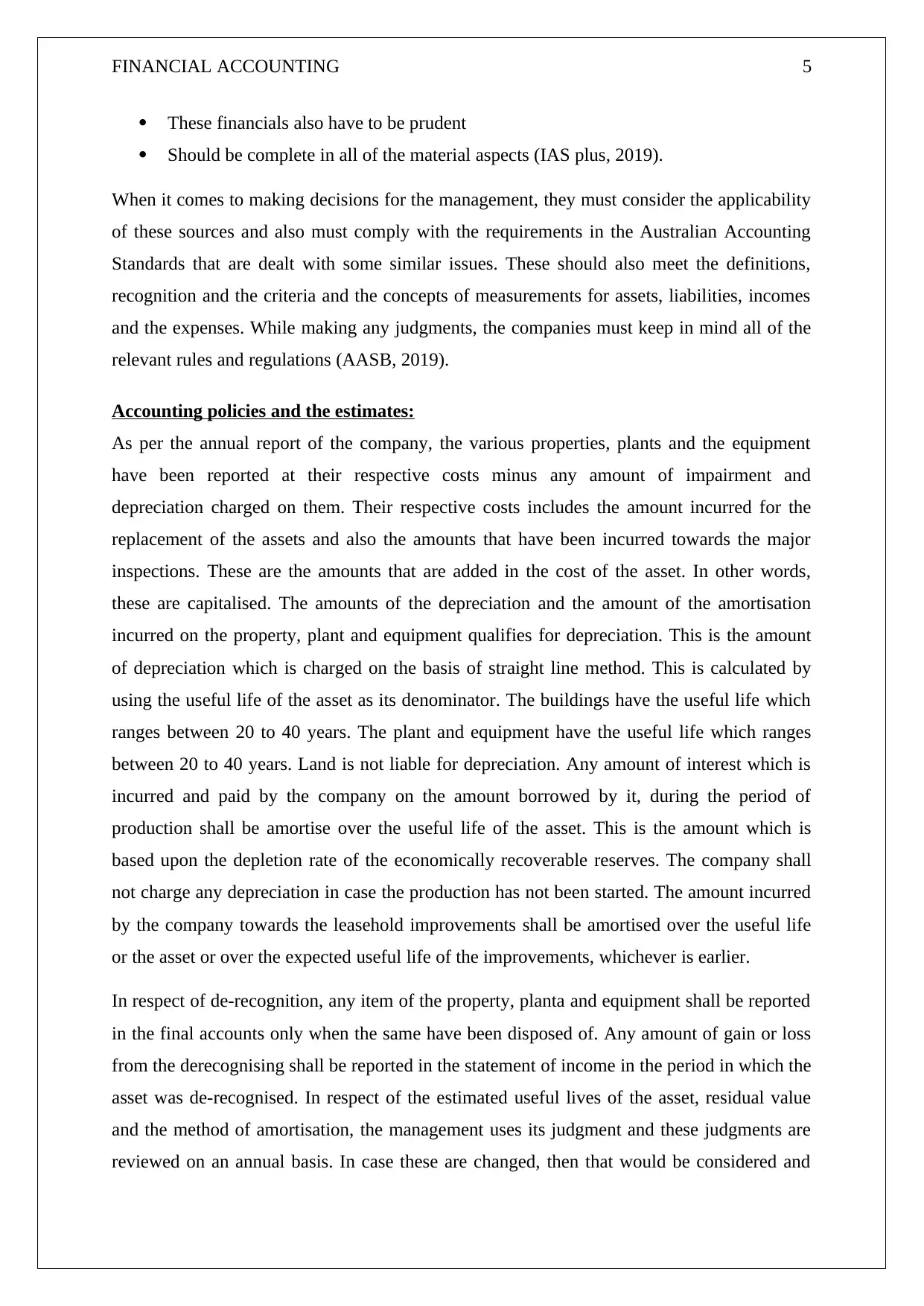
FINANCIAL ACCOUNTING 5
These financials also have to be prudent
Should be complete in all of the material aspects (IAS plus, 2019).
When it comes to making decisions for the management, they must consider the applicability
of these sources and also must comply with the requirements in the Australian Accounting
Standards that are dealt with some similar issues. These should also meet the definitions,
recognition and the criteria and the concepts of measurements for assets, liabilities, incomes
and the expenses. While making any judgments, the companies must keep in mind all of the
relevant rules and regulations (AASB, 2019).
Accounting policies and the estimates:
As per the annual report of the company, the various properties, plants and the equipment
have been reported at their respective costs minus any amount of impairment and
depreciation charged on them. Their respective costs includes the amount incurred for the
replacement of the assets and also the amounts that have been incurred towards the major
inspections. These are the amounts that are added in the cost of the asset. In other words,
these are capitalised. The amounts of the depreciation and the amount of the amortisation
incurred on the property, plant and equipment qualifies for depreciation. This is the amount
of depreciation which is charged on the basis of straight line method. This is calculated by
using the useful life of the asset as its denominator. The buildings have the useful life which
ranges between 20 to 40 years. The plant and equipment have the useful life which ranges
between 20 to 40 years. Land is not liable for depreciation. Any amount of interest which is
incurred and paid by the company on the amount borrowed by it, during the period of
production shall be amortise over the useful life of the asset. This is the amount which is
based upon the depletion rate of the economically recoverable reserves. The company shall
not charge any depreciation in case the production has not been started. The amount incurred
by the company towards the leasehold improvements shall be amortised over the useful life
or the asset or over the expected useful life of the improvements, whichever is earlier.
In respect of de-recognition, any item of the property, planta and equipment shall be reported
in the final accounts only when the same have been disposed of. Any amount of gain or loss
from the derecognising shall be reported in the statement of income in the period in which the
asset was de-recognised. In respect of the estimated useful lives of the asset, residual value
and the method of amortisation, the management uses its judgment and these judgments are
reviewed on an annual basis. In case these are changed, then that would be considered and
These financials also have to be prudent
Should be complete in all of the material aspects (IAS plus, 2019).
When it comes to making decisions for the management, they must consider the applicability
of these sources and also must comply with the requirements in the Australian Accounting
Standards that are dealt with some similar issues. These should also meet the definitions,
recognition and the criteria and the concepts of measurements for assets, liabilities, incomes
and the expenses. While making any judgments, the companies must keep in mind all of the
relevant rules and regulations (AASB, 2019).
Accounting policies and the estimates:
As per the annual report of the company, the various properties, plants and the equipment
have been reported at their respective costs minus any amount of impairment and
depreciation charged on them. Their respective costs includes the amount incurred for the
replacement of the assets and also the amounts that have been incurred towards the major
inspections. These are the amounts that are added in the cost of the asset. In other words,
these are capitalised. The amounts of the depreciation and the amount of the amortisation
incurred on the property, plant and equipment qualifies for depreciation. This is the amount
of depreciation which is charged on the basis of straight line method. This is calculated by
using the useful life of the asset as its denominator. The buildings have the useful life which
ranges between 20 to 40 years. The plant and equipment have the useful life which ranges
between 20 to 40 years. Land is not liable for depreciation. Any amount of interest which is
incurred and paid by the company on the amount borrowed by it, during the period of
production shall be amortise over the useful life of the asset. This is the amount which is
based upon the depletion rate of the economically recoverable reserves. The company shall
not charge any depreciation in case the production has not been started. The amount incurred
by the company towards the leasehold improvements shall be amortised over the useful life
or the asset or over the expected useful life of the improvements, whichever is earlier.
In respect of de-recognition, any item of the property, planta and equipment shall be reported
in the final accounts only when the same have been disposed of. Any amount of gain or loss
from the derecognising shall be reported in the statement of income in the period in which the
asset was de-recognised. In respect of the estimated useful lives of the asset, residual value
and the method of amortisation, the management uses its judgment and these judgments are
reviewed on an annual basis. In case these are changed, then that would be considered and
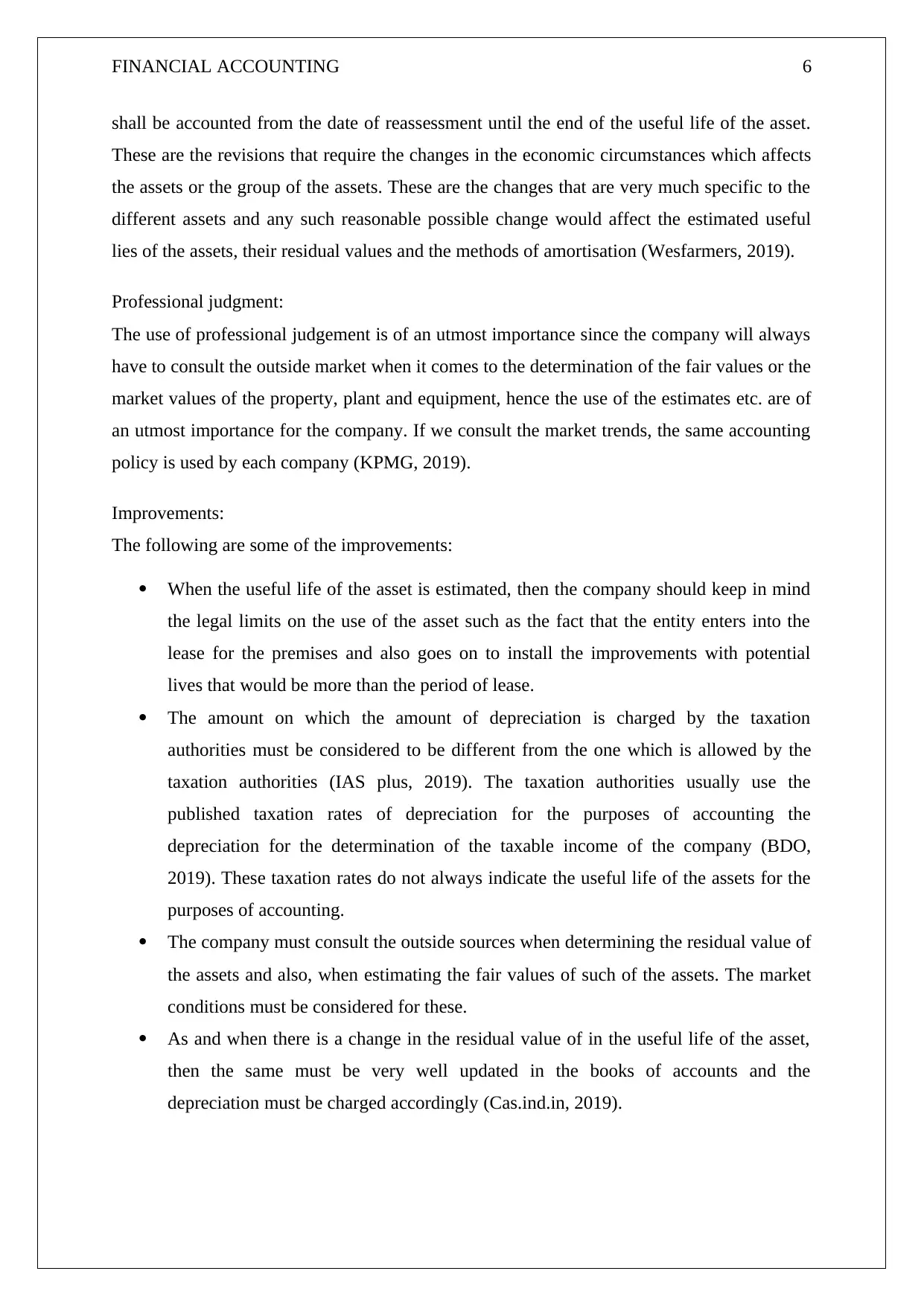
FINANCIAL ACCOUNTING 6
shall be accounted from the date of reassessment until the end of the useful life of the asset.
These are the revisions that require the changes in the economic circumstances which affects
the assets or the group of the assets. These are the changes that are very much specific to the
different assets and any such reasonable possible change would affect the estimated useful
lies of the assets, their residual values and the methods of amortisation (Wesfarmers, 2019).
Professional judgment:
The use of professional judgement is of an utmost importance since the company will always
have to consult the outside market when it comes to the determination of the fair values or the
market values of the property, plant and equipment, hence the use of the estimates etc. are of
an utmost importance for the company. If we consult the market trends, the same accounting
policy is used by each company (KPMG, 2019).
Improvements:
The following are some of the improvements:
When the useful life of the asset is estimated, then the company should keep in mind
the legal limits on the use of the asset such as the fact that the entity enters into the
lease for the premises and also goes on to install the improvements with potential
lives that would be more than the period of lease.
The amount on which the amount of depreciation is charged by the taxation
authorities must be considered to be different from the one which is allowed by the
taxation authorities (IAS plus, 2019). The taxation authorities usually use the
published taxation rates of depreciation for the purposes of accounting the
depreciation for the determination of the taxable income of the company (BDO,
2019). These taxation rates do not always indicate the useful life of the assets for the
purposes of accounting.
The company must consult the outside sources when determining the residual value of
the assets and also, when estimating the fair values of such of the assets. The market
conditions must be considered for these.
As and when there is a change in the residual value of in the useful life of the asset,
then the same must be very well updated in the books of accounts and the
depreciation must be charged accordingly (Cas.ind.in, 2019).
shall be accounted from the date of reassessment until the end of the useful life of the asset.
These are the revisions that require the changes in the economic circumstances which affects
the assets or the group of the assets. These are the changes that are very much specific to the
different assets and any such reasonable possible change would affect the estimated useful
lies of the assets, their residual values and the methods of amortisation (Wesfarmers, 2019).
Professional judgment:
The use of professional judgement is of an utmost importance since the company will always
have to consult the outside market when it comes to the determination of the fair values or the
market values of the property, plant and equipment, hence the use of the estimates etc. are of
an utmost importance for the company. If we consult the market trends, the same accounting
policy is used by each company (KPMG, 2019).
Improvements:
The following are some of the improvements:
When the useful life of the asset is estimated, then the company should keep in mind
the legal limits on the use of the asset such as the fact that the entity enters into the
lease for the premises and also goes on to install the improvements with potential
lives that would be more than the period of lease.
The amount on which the amount of depreciation is charged by the taxation
authorities must be considered to be different from the one which is allowed by the
taxation authorities (IAS plus, 2019). The taxation authorities usually use the
published taxation rates of depreciation for the purposes of accounting the
depreciation for the determination of the taxable income of the company (BDO,
2019). These taxation rates do not always indicate the useful life of the assets for the
purposes of accounting.
The company must consult the outside sources when determining the residual value of
the assets and also, when estimating the fair values of such of the assets. The market
conditions must be considered for these.
As and when there is a change in the residual value of in the useful life of the asset,
then the same must be very well updated in the books of accounts and the
depreciation must be charged accordingly (Cas.ind.in, 2019).
⊘ This is a preview!⊘
Do you want full access?
Subscribe today to unlock all pages.

Trusted by 1+ million students worldwide
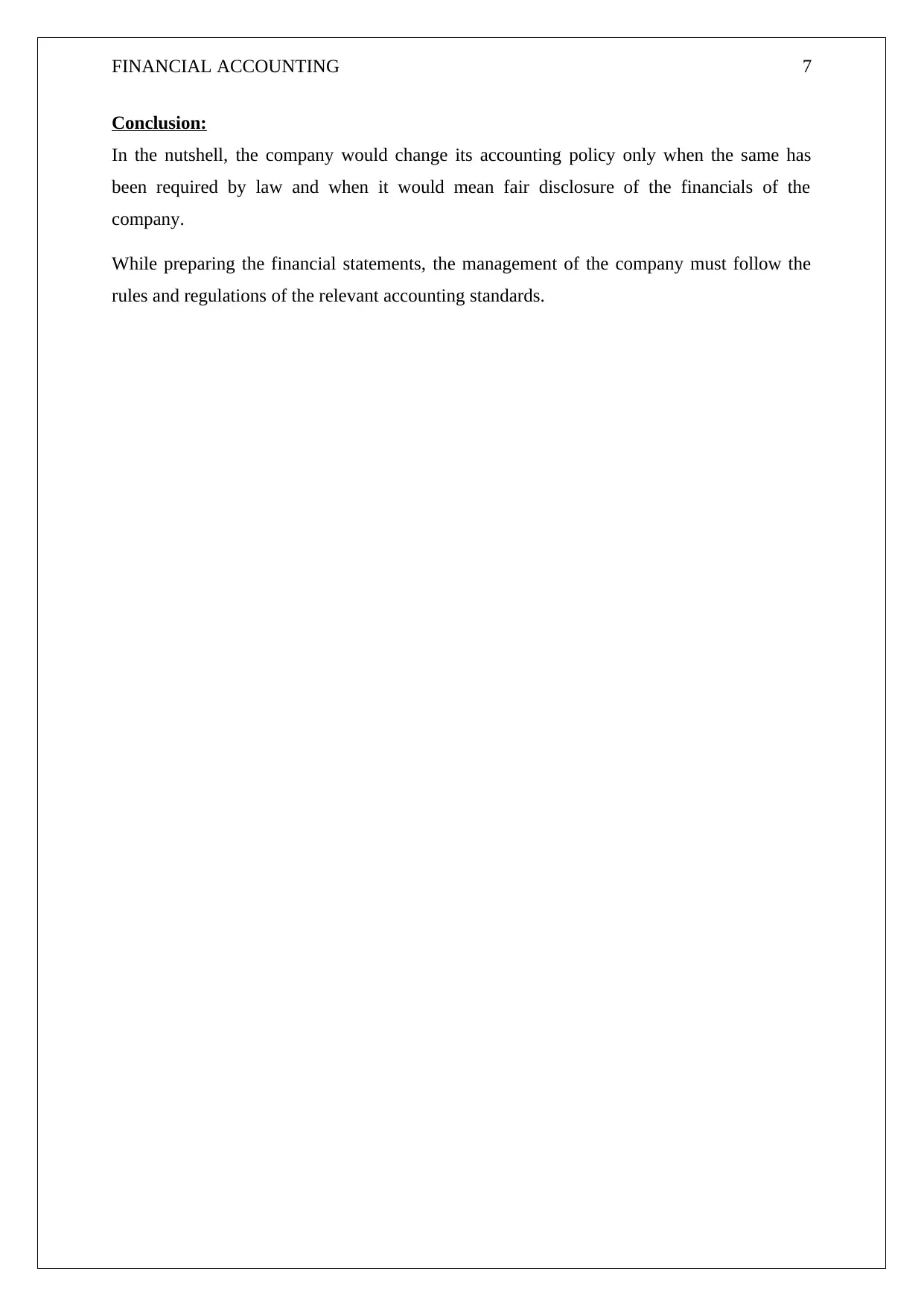
FINANCIAL ACCOUNTING 7
Conclusion:
In the nutshell, the company would change its accounting policy only when the same has
been required by law and when it would mean fair disclosure of the financials of the
company.
While preparing the financial statements, the management of the company must follow the
rules and regulations of the relevant accounting standards.
Conclusion:
In the nutshell, the company would change its accounting policy only when the same has
been required by law and when it would mean fair disclosure of the financials of the
company.
While preparing the financial statements, the management of the company must follow the
rules and regulations of the relevant accounting standards.
Paraphrase This Document
Need a fresh take? Get an instant paraphrase of this document with our AI Paraphraser
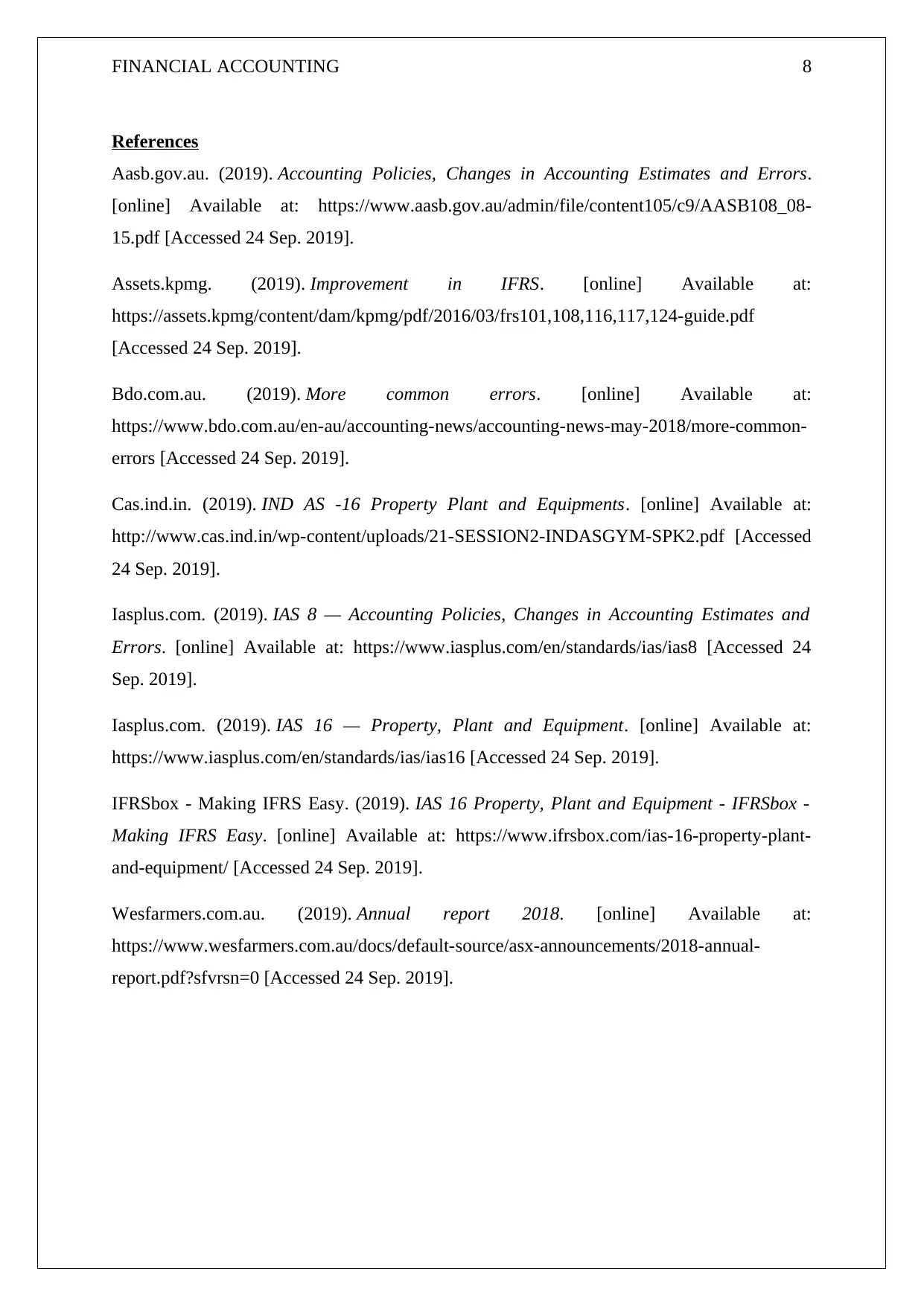
FINANCIAL ACCOUNTING 8
References
Aasb.gov.au. (2019). Accounting Policies, Changes in Accounting Estimates and Errors.
[online] Available at: https://www.aasb.gov.au/admin/file/content105/c9/AASB108_08-
15.pdf [Accessed 24 Sep. 2019].
Assets.kpmg. (2019). Improvement in IFRS. [online] Available at:
https://assets.kpmg/content/dam/kpmg/pdf/2016/03/frs101,108,116,117,124-guide.pdf
[Accessed 24 Sep. 2019].
Bdo.com.au. (2019). More common errors. [online] Available at:
https://www.bdo.com.au/en-au/accounting-news/accounting-news-may-2018/more-common-
errors [Accessed 24 Sep. 2019].
Cas.ind.in. (2019). IND AS -16 Property Plant and Equipments. [online] Available at:
http://www.cas.ind.in/wp-content/uploads/21-SESSION2-INDASGYM-SPK2.pdf [Accessed
24 Sep. 2019].
Iasplus.com. (2019). IAS 8 — Accounting Policies, Changes in Accounting Estimates and
Errors. [online] Available at: https://www.iasplus.com/en/standards/ias/ias8 [Accessed 24
Sep. 2019].
Iasplus.com. (2019). IAS 16 — Property, Plant and Equipment. [online] Available at:
https://www.iasplus.com/en/standards/ias/ias16 [Accessed 24 Sep. 2019].
IFRSbox - Making IFRS Easy. (2019). IAS 16 Property, Plant and Equipment - IFRSbox -
Making IFRS Easy. [online] Available at: https://www.ifrsbox.com/ias-16-property-plant-
and-equipment/ [Accessed 24 Sep. 2019].
Wesfarmers.com.au. (2019). Annual report 2018. [online] Available at:
https://www.wesfarmers.com.au/docs/default-source/asx-announcements/2018-annual-
report.pdf?sfvrsn=0 [Accessed 24 Sep. 2019].
References
Aasb.gov.au. (2019). Accounting Policies, Changes in Accounting Estimates and Errors.
[online] Available at: https://www.aasb.gov.au/admin/file/content105/c9/AASB108_08-
15.pdf [Accessed 24 Sep. 2019].
Assets.kpmg. (2019). Improvement in IFRS. [online] Available at:
https://assets.kpmg/content/dam/kpmg/pdf/2016/03/frs101,108,116,117,124-guide.pdf
[Accessed 24 Sep. 2019].
Bdo.com.au. (2019). More common errors. [online] Available at:
https://www.bdo.com.au/en-au/accounting-news/accounting-news-may-2018/more-common-
errors [Accessed 24 Sep. 2019].
Cas.ind.in. (2019). IND AS -16 Property Plant and Equipments. [online] Available at:
http://www.cas.ind.in/wp-content/uploads/21-SESSION2-INDASGYM-SPK2.pdf [Accessed
24 Sep. 2019].
Iasplus.com. (2019). IAS 8 — Accounting Policies, Changes in Accounting Estimates and
Errors. [online] Available at: https://www.iasplus.com/en/standards/ias/ias8 [Accessed 24
Sep. 2019].
Iasplus.com. (2019). IAS 16 — Property, Plant and Equipment. [online] Available at:
https://www.iasplus.com/en/standards/ias/ias16 [Accessed 24 Sep. 2019].
IFRSbox - Making IFRS Easy. (2019). IAS 16 Property, Plant and Equipment - IFRSbox -
Making IFRS Easy. [online] Available at: https://www.ifrsbox.com/ias-16-property-plant-
and-equipment/ [Accessed 24 Sep. 2019].
Wesfarmers.com.au. (2019). Annual report 2018. [online] Available at:
https://www.wesfarmers.com.au/docs/default-source/asx-announcements/2018-annual-
report.pdf?sfvrsn=0 [Accessed 24 Sep. 2019].
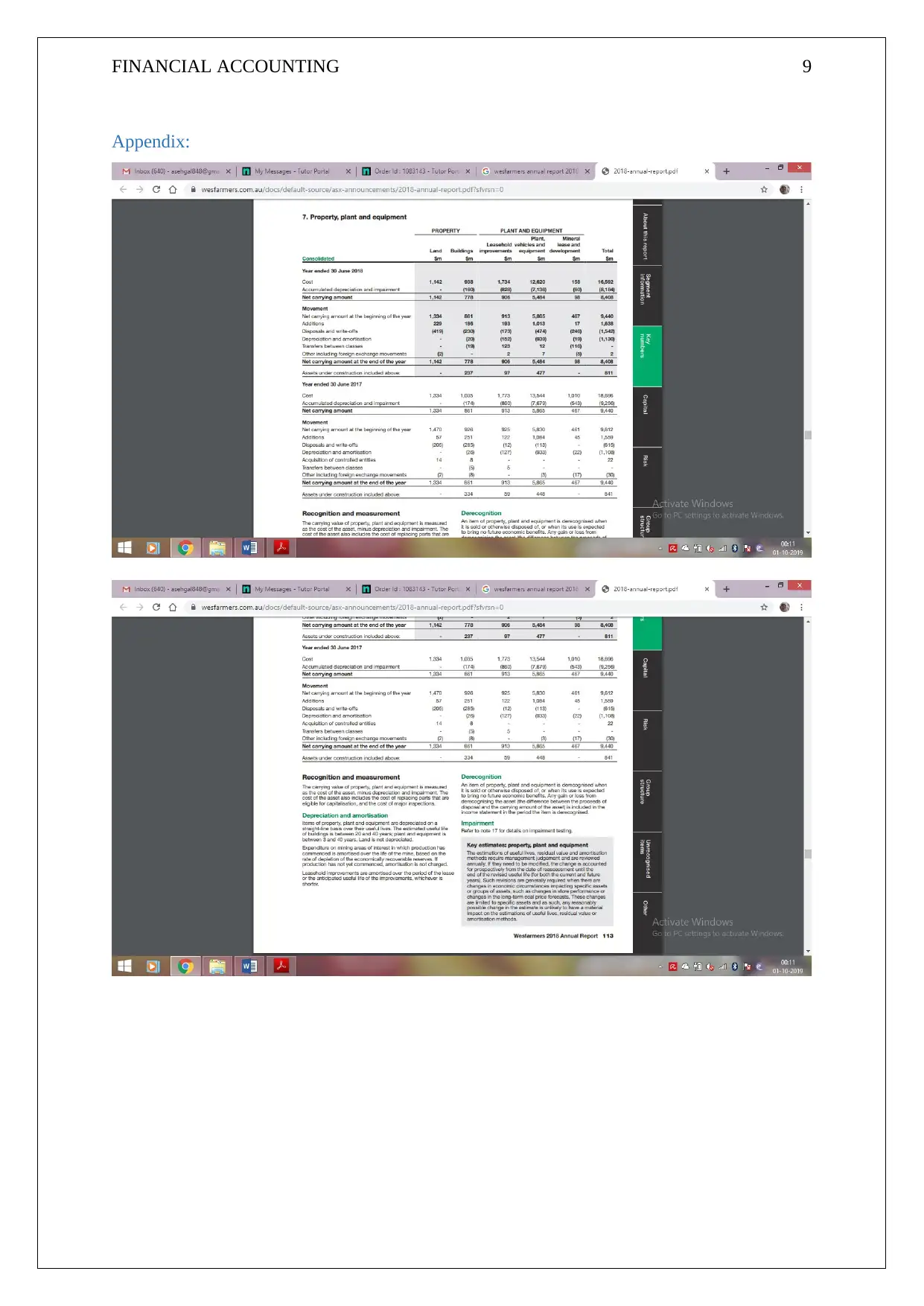
FINANCIAL ACCOUNTING 9
Appendix:
Appendix:
⊘ This is a preview!⊘
Do you want full access?
Subscribe today to unlock all pages.

Trusted by 1+ million students worldwide
1 out of 9
Related Documents
Your All-in-One AI-Powered Toolkit for Academic Success.
+13062052269
info@desklib.com
Available 24*7 on WhatsApp / Email
![[object Object]](/_next/static/media/star-bottom.7253800d.svg)
Unlock your academic potential
Copyright © 2020–2025 A2Z Services. All Rights Reserved. Developed and managed by ZUCOL.





